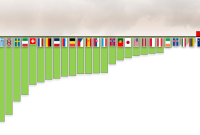Support strong Canadian climate journalism for 2025
The short-tailed albatross were creatures of habit, according to a new study that found they returned to Vancouver Island to feed for generations over a 4,200-year period before being driven to the precipice of extinction by feather hunters.
The evidence may be the key to helping the birds back from extinction, said the study's lead author, Eric Guiry, a lecturer at the University of Leicester in England.
The birds' potential ranges span thousands of kilometres of wide, open spaces along the Pacific coastline and across oceans, but Guiry said the animals still preferred certain hunting and feeding grounds.
"This kind of feeding behaviour has only recently been discovered in birds today," he said in an interview. "But we've got evidence of it happening over thousands of years. The same birds go into the same area for their entire lives."
Researchers analyzed these foraging patterns using chemical fingerprints, or isotopic compositions, preserved in the bones of albatross that were found through archeological digs and museum samples, said the study published this month in the open-access journal Communications Biology.
One of the sites where researchers collected ancient bone samples, a Mowachaht Nuu-chah-nulth village on Nootka Island off Vancouver Island's west coast, dated as far back as 2300 BC. The study compared samples found on Vancouver Island with those in the United States, Russia and Japan.
Scientists were able to connect various dots with the chemical fingerprints to piece together the puzzle of the migration and feeding pattern of the short-tailed albatross over 4,250 years, Guiry said.
By mapping the biological markers against known isotopic baselines across the species' foraging range — which was thousands and thousands of kilometres each migration year — the researchers were able to build a picture of the birds' migratory and foraging behaviour over hundreds of generations, he said.
The foraging behaviour of birds gives researchers an insight into their vulnerability, he said.
The short-tailed albatross was almost wiped out for their feathers between the 1880s and 1930s, leaving no functioning breeding colonies in the North Pacific, from Japan to Russia, Vancouver Island south to California, the study said.
Known for their pink bills, the wingspan of the albatross can exceed two metres. Their white and grey feathers fade to yellow on their heads.
Once numbering in the millions, the seabirds are regaining in population, but they remain at less than one per cent of their pre-collapse levels. The birds are classified as threatened by the Committee on the Status of Endangered Wildlife in Canada.
"As population growth continues, understanding the factors governing how and where short-tailed albatrosses select, and apportion their time between, specific foraging areas may be key for developing effective conservation approaches," the study reads.
Guiry said the birds will have "good reasons" to come back to the same locations to find food. He said it wasn't clear what the birds were eating then, but they know squid was in their diet.
"They'll be particularly rich areas of hot spots for feeding. This particularly happens where you have upwelling and strong winds occurring, so a lot of nutrient rich water coming up, and that's important for the kinds of foods they're looking for."
This behaviour might come back as the population rebounds, he said.
"The fact that this appears to be happening to such degree for such a long time makes you wonder whether there's something more fundamental going on."
What surprised him most, Guiry said, was the unchanging path and pattern.
"Just the sheer distance that they're travelling over thousands of kilometres to the same sorts of areas," he said. "The fact that a species travelling tremendous distances, and it's happening generation upon generation for thousands of years. That's just a remarkable degree of consistency."
This report by The Canadian Press was first published April 18, 2022.




Comments